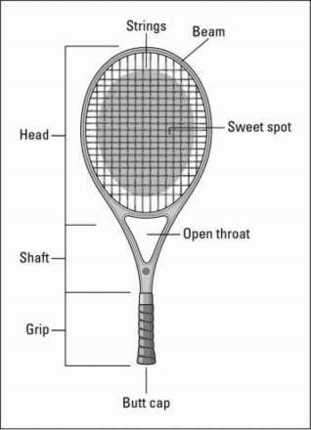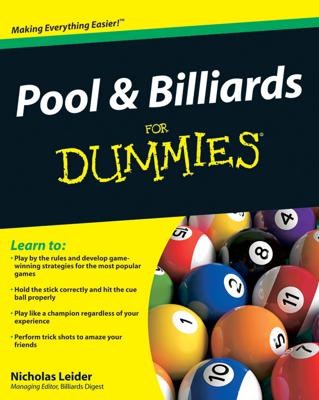Yes, you can dust off that racquet that you played with five years ago and give it a glorious return to the court — if it feels good in your hand and it gets your shots where (and how) you want them to go.
If you're in the market for a new weapon, however, you need to understand the build of a racquet so that you know what's up when you set out to select your new tool. When dealing with sporting goods salespeople, knowing how to talk the talk about racquets really helps.
Sizing up the frame
Welcome to Tennis Racquet Anatomy 101, where you can find out all the different parts that make up a standard racquet frame, shown in Figure 1.
 |
Figure 1: The components of a typical racquet frame. |
Here's a more detailed breakdown of those items:
- The head and the sweet spot: The entire area inside the head (where the strings are) is called the strung surface. The strung surface always contains a sweet spot — the area in which the strings create the most power for the least amount of effort. The sweet spot is the tennis player's favorite area of the racquet.
- The head of a racquet can vary in shape and size. Typically, a racquet's head falls into one of the following categories:
Over-sized: Beginners really like the over-sized and even jumbo frames, which offer between 100 and a whopping 140 square inches of strung surface. Such frames give you a larger sweet spot simply because the hitting surface is bigger, and they allow you to hit the ball farther from the heart of the sweet spot and still make a good shot.
Mid-sized: These racquet heads range from 85 to 100 square inches. Most pro players use frames on the low side of mid-sized — between 85 and 95 square inches. Most recreational players gravitate to the high side of mid-sized — between 95 and 100 square inches. Mid-size racquets offer a great compromise between a larger strung surface and sweet spot and a maneuverable frame that lets you generate good racquet speed when you swing.
Standard-sized heads: Ranging from 80 to 85 square inches, standard-size heads are now obsolete. They give you a smaller strung surface and sweet spot, making it more difficult to produce crisp, clean shots.
- The beam: The beam is the area on either side of the head. The beam does not increase the length or width of a racquet, but it increases the racquet's depth (or thickness). If you look at a couple racquets from the side, you notice that some racquets have wider beams than others.
- Wide beams can add power to your shots. However, many players find that a wide beam enhances the trampoline effect of the strings to such a degree that they have trouble controlling the direction of their shots. The lack of control can lead you to start chopping and poking at the ball rather than taking a smooth, long swing.
Stick with a moderate beam, straight or slightly tapered, until you have enough experience to experiment with more extreme beam configurations. By that time, you'll be able to determine how wider beams affect your strokes and playing style.
- The throat and shaft: The open throat design has become the standard in racquets, virtually eliminating the traditional lollipop construction, which is simply a closed throat design.
Use a racquet with an open throat because it stabilizes the racquet head better than the straight shaft design. The open throat compensates for off-center hits, effectively enlarging the sweet spot.
- The point at which the two curved sides of throat come closest together and then extend straight down to the racquet handle is the shaft. Basically, the throat becomes the shaft.
- The grip: At the end of the shaft, you find the grip. Racquet grips range in diameter between 4 and 4-5/8 inches around. No objective criteria exist for choosing a grip size. Grip size is purely a matter of comfort.
- If you don't have a preference, tennis has an old rule of thumb — literally. When you grip the racquet comfortably (but not tightly), you should be able to touch the tip of your thumb to the top (or outermost) knuckle of your middle finger.
If you're torn between two similar grip diameters, go with the smaller one, for this reason: You can always build up the grip later with grip tape.
- The butt cap: The tail end of the racquet, the butt cap does not impact your play. Most racquet manufacturers put their logo on the butt cap. Many players use this logo to determine who gets to serve first in a match.
- The overall length: Longer racquets give you more reach to the ball, and they give you a little more power, especially on the serve. But the added length also makes a racquet a little more difficult to control. You need better timing and eye-hand coordination to meet the ball with the sweet spot.
Tennis is a game of controlled power. As a beginner, you should establish your game with a standard-length racquet (27 inches) and then trade up to longer racquets after you master your control.
- The weight: Racquets have lost a lot of weight in recent years because of the space-age materials from which they're made. Most racquets now weigh between 9 and 12 ounces, unstrung.
You should be able to feel the weight of a racquet; it's a valuable aid to your eye-hand coordination. Use a racquet that has some heft without feeling heavy in your hand — light enough to swing easily and securely, heavy enough to provide you with good power.
Racquet materials
A whole smorgasbord of racquet materials awaits you at the sporting goods store. You may need a little help sorting through the offerings, so here's a list of the most common racquet materials you come across:
- Graphite: The vast majority of racquets manufactured today use graphite in one form or another as the base ingredient. Graphite is the technological generation's equivalent of the trusty laminated wooden racquet that was so popular until about the 1970s.
- Graphite is remarkably strong for its relatively light weight. It provides terrific power, as well as good control and feel for the ball. But graphite is best in a composite mixture with any of the various thermoplastic- and fiberglass-type resins used today. Graphite-composite racquets are great for beginners as well as advanced players because stiffer racquets transmit shock and vibration to the arm and shoulders.
- Boron and Kevlar: These two fibers resemble graphite, but boron and Kevlar are even lighter and stiffer than graphite. Kevlar is also used to make bulletproof vests — now that's stiff. Unless mixed with other materials, however, Kevlar's stiffness can transmit a lot of shock and vibration to your arm and shoulder, especially if you don't hit the ball on the sweet spot.
- Beginners should stay away from these materials.
- Aluminum: You find this old standby still used, particularly in less expensive racquets. Aluminum offers decent power and a surprising amount of feel. Feel is the sensation you get for how you're striking the ball and where it's going. Some racquet materials are more sensitive than others to things like impact and vibration, so they transmit information about them more readily.
- Recently, a clutch of new racquets made from a very strong, extremely light material called titanium has hit the market. Titanium is similar to aluminum. Either aluminum or titanium is an acceptable choice for beginners.
- Oldies but woodies: Many people still have wood or fiberglass racquets lying around collecting cobwebs in the attic or cellar. You can use these racquets, but doing so won't help your game any. All those racquets feature the obsolete, standard-sized heads. Why make the game harder than it has to be by using ancient, outdated tools?

